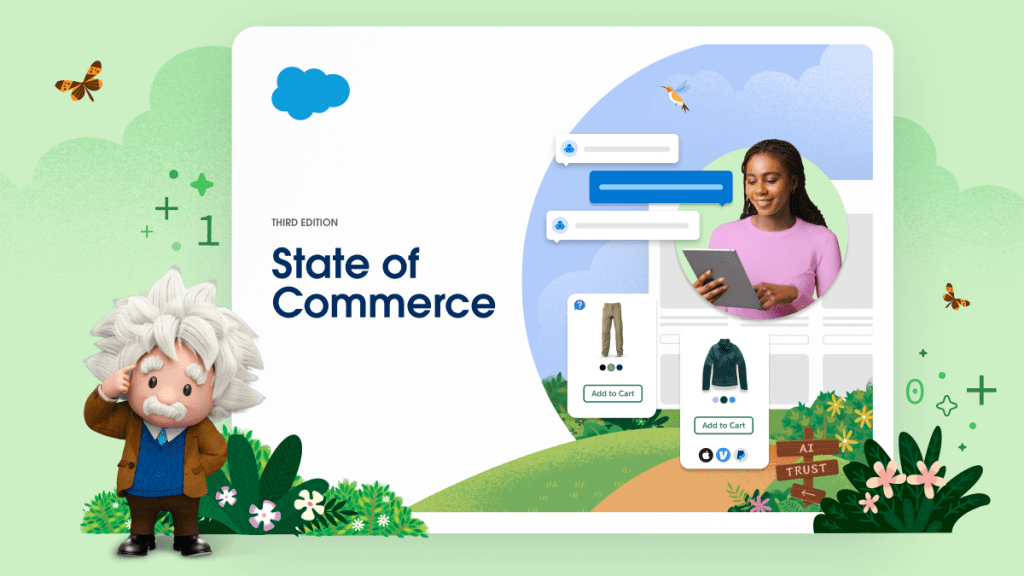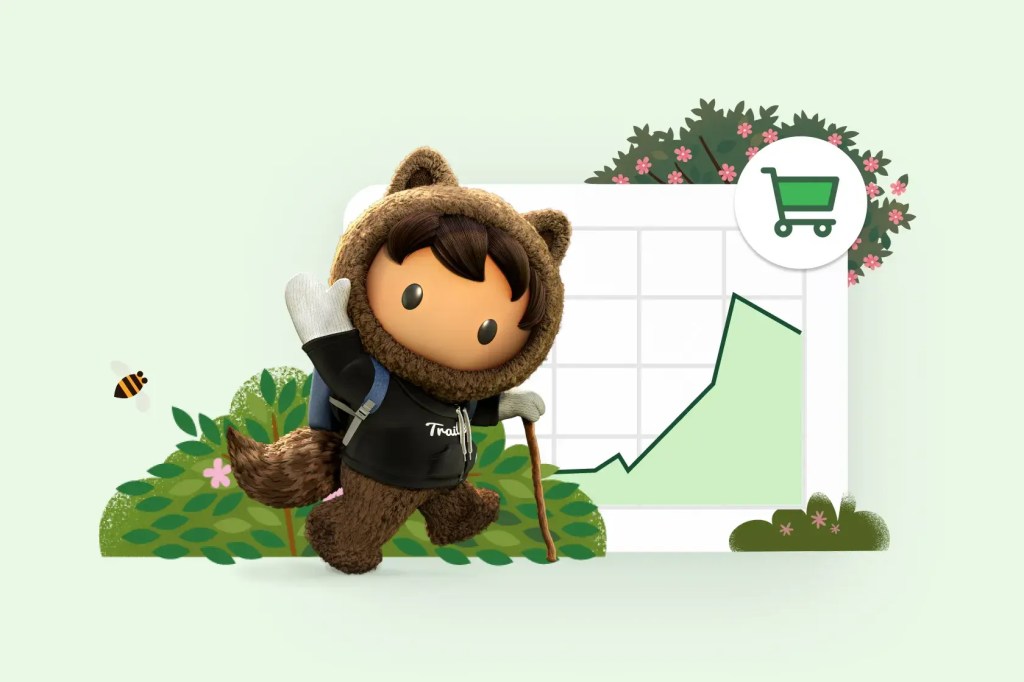
10 Ecommerce Trends That Will Influence Online Shopping in 2024
Learn what ecommerce leaders are prioritizing — and how to stay ahead in a changing market.
By Lauren Wallace

Learn what ecommerce leaders are prioritizing — and how to stay ahead in a changing market.
By Lauren Wallace


Some ecommerce trends and technologies pass in hype cycles, but others are so powerful they change the entire course of the market. After all the emerging ecommerce technologies and innovations that cropped up in 2024, business leaders are assessing how to move forward and which new trends to implement. Here are some of the biggest trends that will affect your business over the coming year.

AI. Productivity. New priorities and solutions. See what leaders are prioritizing.
There’s no doubt about it: Artificial intelligence (AI) is changing the ecommerce game. Commerce teams have been using the technology for years to automate and personalize product recommendations, chatbot activity, and more. But now, generative and predictive AI trained on large language models (LLM) offer even more opportunities to increase efficiency and scale personalization. AI is more than an ecommerce trend — it can make your teams more productive and your customers more satisfied.
Do you have a large product catalog that needs to be updated frequently? AI can write and categorize individual descriptions, cutting down hours of work to mere minutes. Do you need to optimize product detail pages? AI can help with SEO by automatically generating meta titles and meta descriptions for every product. Need to build a landing page for a new promotion? Generative page designers let users of all skill levels create and design web pages in seconds with simple, conversational building tools.
All this innovation will make it easier to keep up with other trends, meet customers’ high expectations, and stay flexible — no matter what comes next.
Data is your most valuable business asset. It’s how you understand your customers, make informed decisions, and gauge success. So it’s critical to make sure your data is in order. The challenge? Businesses collect a lot of it, but they don’t always know how to manage it.
That’s where data management and harmonization come in. They bring together data from multiple sources — think your customer relationship management (CRM) and order management systems — to provide a holistic view of all your business activities. With harmonized data, you can uncover insights and act on them much faster to increase customer satisfaction and revenue. Harmonized data also makes it possible to implement AI (including generative AI), automation, and machine learning to help you market, serve, and sell more efficiently.
That’s why data management and harmonization are top priorities among business leaders
For businesses looking to take advantage of all the new AI capabilities in ecommerce, data management should be priority number one.
Remember when chatbot experiences felt robotic and awkward? Those days are over. Thanks to generative AI and LLMs, conversational commerce is getting a glow-up. Interacting with chatbots for service inquiries, product questions, and more via messaging apps and websites feels much more human and personalized.
Chatbots can now elevate online shopping with conversational AI and first-party data, mirroring the best in-store interactions across all digital channels. Natural language, image-based, and data-driven interactions can simplify product searches, provide personalized responses, and streamline purchases for a smooth experience across all your digital channels.
As technology advances, this trend will gain more traction. Intelligent AI chatbots offer customers better self-service experiences and make shopping more enjoyable. This is critical since 68% of customers say they wouldn’t use a company’s chatbot again if they had a bad experience.

Scale your business with the most complete commerce platform.
Headless commerce continues to gain steam. With this modular architecture, ecommerce teams can deliver new experiences faster because they don’t have to wait in the developer queue to change back-end systems. Instead, employees can update online interfaces using APIs, experience managers, and user-friendly tools. According to business leaders and commerce teams already using headless:
Customers reap the benefits of headless commerce, too. Shoppers get fresh experiences more frequently across all devices and touchpoints. Even better? Headless results in richer personalization, better omni-channel experiences, and peak performance for ecommerce websites.

Sign up for our monthly commerce newsletter to get the latest research, industry insights, and product news delivered straight to your inbox.
Over the past few years, consumers have shifted their mindset about resale items. Secondhand purchases that were once viewed as stigma are now seen as status. In fact, more than half of consumers (52%) have purchased an item secondhand in the last year, and the resale market is expected to reach $70 billion by 2027. Simply put: Resale presents a huge opportunity for your business.
As the circular economy grows in popularity, brands everywhere are opening their own resale stores and encouraging consumers to turn in used items, from old jeans to designer handbags to kitchen appliances. To claim your piece of the pie, be strategic as you enter the market. This means implementing robust inventory and order management systems with real-time visibility and reverse logistics capabilities.
Now that shoppers have become accustomed to the vibrant, attention-grabbing video content on social platforms, they expect the same from your brand’s ecommerce site. Video can offer customers a deeper understanding of your products, such as how they’re used, and what they look like from different angles.
And video content isn’t just useful for ads or for increasing product discovery. Brands are having major success using video at every stage of the customer journey: in pre-purchase consultations, on product detail pages, and in post-purchase emails. A large majority (89%) of consumers say watching a video has convinced them to buy a product or service.
It’s important to attract new customers, but it’s also critical to retain your existing ones. That means you need to find ways to increase loyalty and build brand love. More and more, customers are seeking out brand loyalty programs — but they want meaningful rewards and experiences. So, what’s the key to a successful loyalty program? In a word: personalization.
Customers don’t want to exchange their data for a clunky, impersonal experience where they have to jump through hoops to redeem points. They want straightforward, exclusive offers. Curated experiences. Relevant rewards. Six out of 10 consumers want discounts in return for joining a loyalty program, and about one-third of consumers say they find exclusive or early access to products valuable.
The brands that win customer loyalty will be those that use data-driven insights to create a program that keeps customers continually engaged and satisfied.
User-generated content (UGC) adds credibility, authenticity, and social proof to a brand’s marketing efforts — and can significantly boost sales and brand loyalty. In fact, one study found that shoppers who interact with UGC experience a 102.4% increase in conversions. Most shoppers expect to see feedback and reviews before making a purchase, and UGC provides value by showcasing the experiences and opinions of real customers.
UGC also breaks away from generic item descriptions and professional product photography. It can show how to style a piece of clothing, for example, or how an item will fit across a range of body types. User-generated videos go a step further, highlighting the functions and features of more complex products, like consumer electronics or even automobiles.
UGC is also a cost-effective way to generate content for social commerce without relying on agencies or large teams. By sourcing posts from hashtags, tagging, or concentrated campaigns, brands can share real-time, authentic, and organic social posts to a wider audience.
UGC can be used on product pages and in ads, as well. And you can incorporate it into product development processes to gather valuable input from customers at scale.
From streaming platforms to food, clothing, and pet supplies, subscriptions have become a popular business model across industries. In 2023, subscriptions generated over $38 billion in revenue, doubling over the past four years. That’s because subscriptions are a win-win for shoppers and businesses: They offer freedom of choice for customers while creating a continuous revenue stream for sellers.
Consider consumer goods brand KIND Snacks. KIND implemented a subscription service to supplement its B2B sales, giving customers a direct line to exclusive offers and flavors. This created a consistent revenue stream for KIND and helped it build a new level of brand loyalty with its customers. The subscription also lets KIND collect first-party data, so it can test new products and spot new trends.
If you’re trying to decide whether to adopt a new trend, the first step is to conduct a cost/benefit analysis. As you do, remember to prioritize customer experience and satisfaction. Look at customer data to evaluate the potential impact of the trend on your business. How costly will it be to implement the trend, and what will the payoff be one, two, and five years into the future? Analyze the numbers to assess whether the trend aligns with your customers’ preferences and behaviors.
You can also take a cue from your competitors and their adoption of specific trends. While you shouldn’t mimic everything they do, being aware of their experiences can provide valuable insights and help gauge the viability of a trend for your business. Ultimately, customer-centric decision-making should guide your evaluation.
In a word: yes. In fact, ecommerce is a top priority for businesses across industries, from healthcare to manufacturing. Customers expect increasingly sophisticated digital shopping experiences, and digital channels continue to be a preferred purchasing method. Ecommerce sales are expected to reach $8.1 trillion by 2026. As digital channels and new technologies evolve, so will customer behaviors and expectations.
Generative AI is revolutionizing ecommerce by enhancing customer experiences and increasing productivity, conversions, and customer loyalty. But to reap the benefits, it’s critical to keep a few things in mind. First is customer trust. A majority of customers (68%) say advances in AI make it more important for companies to be trustworthy. This means businesses implementing AI should focus on transparency. Tell customers how you will use their data to improve shopping experiences. Develop ethical standards around your use of AI, and discuss them openly.
You’ll need to answer tough questions like: How do you ensure sensitive data is anonymized? How will you monitor accuracy and audit for bias, toxicity, or hallucinations? These should all be considerations as you choose AI partners and develop your code of conduct and governance principles.
At a time when only 13% of customers fully trust companies to use AI ethically, this should be top of mind for businesses delving into the fast-evolving technology.
Before implementing a new experience or ecommerce trend, set key performance indicators (KPIs) and decide how you’ll track relevant ecommerce metrics. This helps you make informed decisions and monitor the various moving parts of your business. From understanding inventory needs to gaining insights into customer behavior to increasing loyalty, you’ll be in a better position to plan for future growth.
The choice of metrics will depend on the needs of your business, but it’s crucial to establish a strategy that outlines metrics, sets KPIs, and measures them regularly. Your business will be more agile and better able to adapt to new ecommerce trends and understand customer buying patterns. Ecommerce metrics and KPIs are valuable tools for building a successful future and will set the tone for future ecommerce growth.
Tell us a bit more so the right person can reach out faster.
Get the latest research, industry insights, and product news delivered straight to your inbox.
6. Social commerce is evolving
There are almost 5 billion![Opens in a new window]() monthly active users on platforms like Instagram, Facebook, Snapchat, and TikTok. More than two-thirds (67%) of global shoppers
monthly active users on platforms like Instagram, Facebook, Snapchat, and TikTok. More than two-thirds (67%) of global shoppers![Opens in a new window]() have made a purchase through social media this year.
have made a purchase through social media this year.
Social commerce instantly connects you with a vast global audience and opens up new opportunities to boost product discovery, reach new markets, and build meaningful connections with your customers. But it’s not enough to just be present on social channels. You need to be an active participant and create engaging, authentic experiences for shoppers.
Thanks to new social commerce tools — like generative AI for content creation and integrations with social platforms — the shopping experience is getting better, faster, and more engaging. This trend is blurring the lines between shopping and entertainment, and customer expectations are rising as a result.